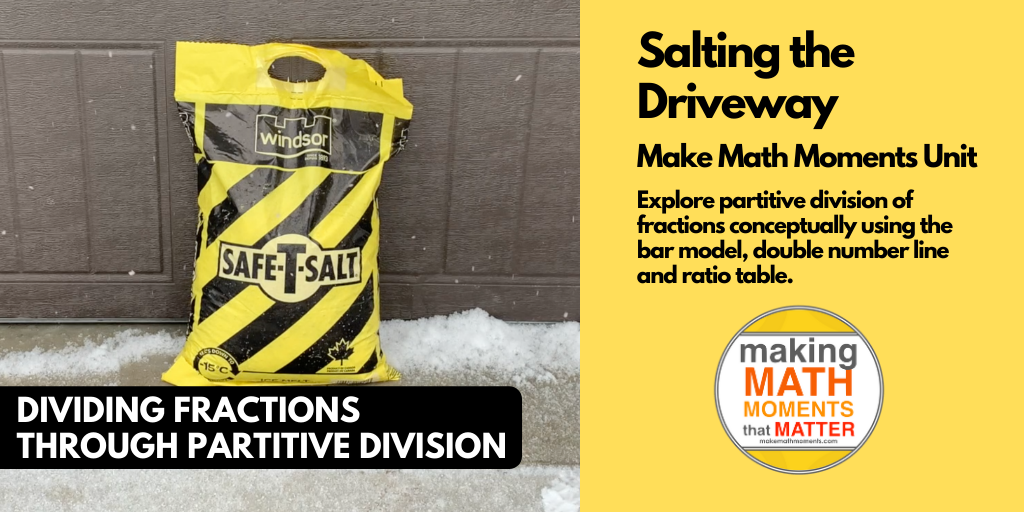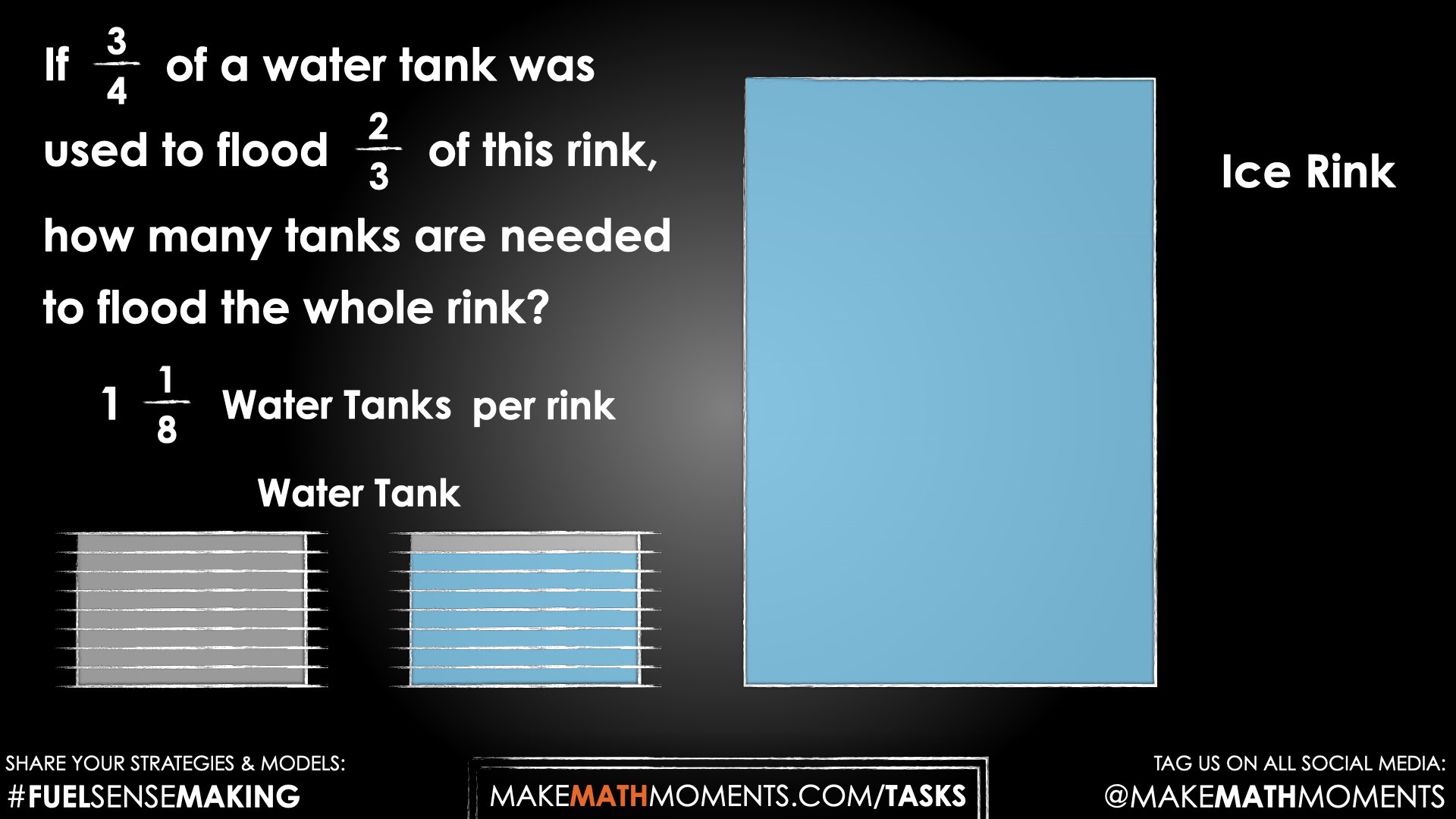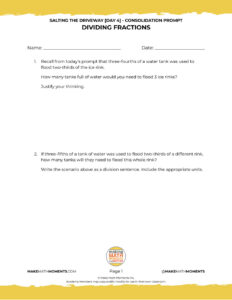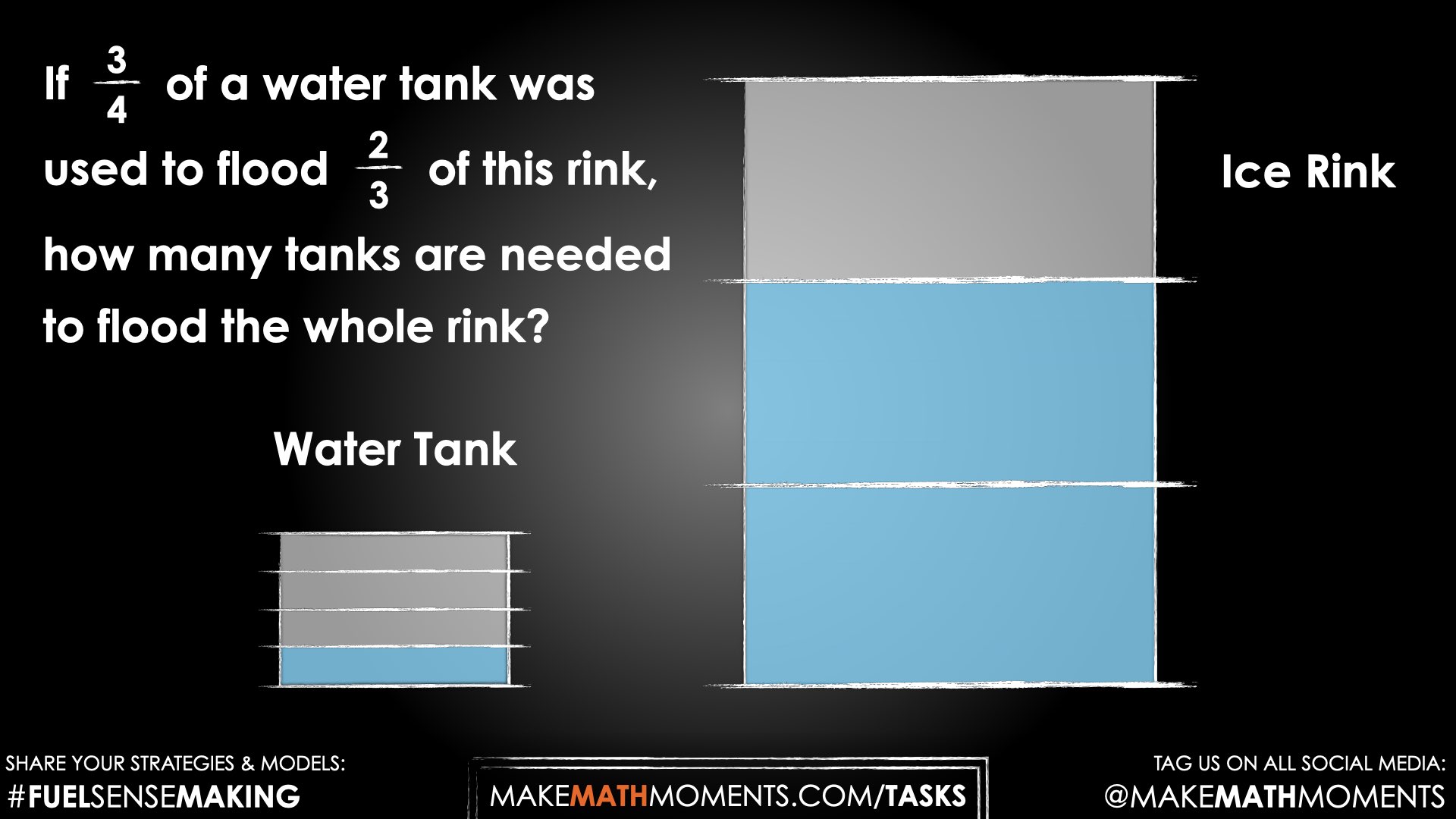Task Teacher Guide
Be sure to read the teacher guide prior to running the task. When you’re ready to run the task, use the tabs at the top of the page to navigate through the lesson.
In This Task…
Students will determine the number of tanks of water needed to flood a backyard skating rink.
Intentionality…
In today’s Math Talk, students will explore halving fractions by either halving the numerator or doubling the denominator. The strategy of partition each part and dounIn the task, students will observe a tank of water being drained as the contents are used to flood a second outdoor skating rink. Students will be asked to divide the ratio through partitive division in order to determine the number of tanks per rink.
You will notice that the relationship between the parts of the tank and parts of the rink is less friendly than the ratio explored on Day 3. Today the ratio is three parts tank to two parts rink. This ratio may require students to partition and modify the denominators.
Some of the big ideas that may emerge through this task include:
- Partitive division is one of the two types of division;
- When dividing partitively, the dividend and the divisor often (not always) have two distinct units;
- The resulting quotient has a compound unit (quantity of dividend per one unit of divisor);
- The dividend and the divisor are a ratio before the division is performed;
- The quotient in a partitive division problem is a rate;
- The quotient can be revealed through scaling the ratio in tandem to one whole of the divisor;
- There are two ways to half a fraction:
- Half the numerator in order to half the number of parts while leaving the size of each part untouched (i.e.: half of \(\frac{4}{6}\) is \(\frac{2}{6}\); or,
- Double the denominator. Double the number of parts that make up the whole by partitioning the existing parts in half, and keep the number of parts (the numerator) the same (i.e.: half of \(\frac{4}{6}\) is \(\frac{4}{12}\)).
Math Talk
Related String of Problems
In today’s math talk, students will explore two ways to half a fraction. Sometimes, it will be obvious that you will need half as many parts. However, when the numerator is not divisible by two, another option is to half the size of the parts, ultimately doubling the number of parts in the whole (or doubling the denominator).
You might consider leveraging the water tank and ice rink context as well as an area model to support student thinking. Students are encouraged to model their way through this math talk.
Determine half of…
\(\frac{2}{4}\)
\(\frac{1}{2}\)
Login/Join to access the entire Teacher Guide, downloadable slide decks and printable handouts for this lesson and all problem based units.
Sense Making
Crafting A Productive Struggle: Prompt
Login/Join to access the entire Teacher Guide, downloadable slide decks and printable handouts for this lesson and all problem based units.
During Moves
While Students Are Productively Struggling…
Login/Join to access the entire Teacher Guide, downloadable slide decks and printable handouts for this lesson and all problem based units.
Student Approach #1: Area Model with Fourths (Repeated Addition)
Login/Join to access the entire Teacher Guide, downloadable slide decks and printable handouts for this lesson and all problem based units.
Student Approach #2: Bar Model with Eighths (Skip Counting)
Login/Join to access the entire Teacher Guide, downloadable slide decks and printable handouts for this lesson and all problem based units.
Student Approach #3: Number Line with Eighths
Login/Join to access the entire Teacher Guide, downloadable slide decks and printable handouts for this lesson and all problem based units.
Student Approach #4: Ratio Table with Fourths and Multiplicative Thinking
Login/Join to access the entire Teacher Guide, downloadable slide decks and printable handouts for this lesson and all problem based units.
Next Moves
Consolidation: Making Connections
Login/Join to access the entire Teacher Guide, downloadable slide decks and printable handouts for this lesson and all problem based units.
Reveal
After making connections during the consolidation phase, you can share the following reveal video:
Here is a screenshot of the final frame you might consider leaving up on the screen as students discuss what happened compared to what they anticipated based on their models:
Reflect
Students will complete the following task and reflection independently without the use of a calculator.
Consolidation Prompt #1:
Login/Join to access the entire Teacher Guide, downloadable slide decks and printable handouts for this lesson and all problem based units.
Consolidation Prompt #2:
Login/Join to access the entire Teacher Guide, downloadable slide decks and printable handouts for this lesson and all problem based units.
Consolidation Prompt #3:
Login/Join to access the entire Teacher Guide, downloadable slide decks and printable handouts for this lesson and all problem based units.
We suggest collecting this reflection as an additional opportunity to engage in the formative assessment process to inform next steps for individual students as well as how the whole class will proceed.
Download Editable/Printable Handout
Become a member to access purposeful practice to display via your projector/TV, download the PDF to upload to your LMS and/or print for students to have a physical copy
Resources and Downloads
Lesson Tip Sheet

Download the lesson plan in PDF format so you can keep it handy and share with colleagues.
Videos & Images
 Download the videos, images, and related media files to your computer to avoid streaming.
Download the videos, images, and related media files to your computer to avoid streaming.
Keynote Slides
 Download in Apple Keynote format to avoid streaming video and run the lesson smoothly.
Download in Apple Keynote format to avoid streaming video and run the lesson smoothly.
PowerPoint Slides
 Download in Microsoft PowerPoint format to avoid streaming video and run the lesson smoothly.
Download in Microsoft PowerPoint format to avoid streaming video and run the lesson smoothly.
Printable Handout
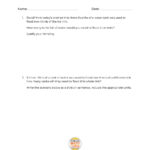
Download/edit the handout so you can keep it handy and share with colleagues.
Explore The Entire Unit of Study
This Make Math Moments Task was designed to spark curiosity for a multi-day unit of study with built in purposeful practice, and extensions to elicit and emerge mathematical models and strategies.
Click the links at the top of this task to head to the other related lessons created for this unit of study.
Determine half of…
\(\frac{2}{4}\)
…
\(\frac{1}{2}\)
…
Login/Join to access the entire Teacher Guide, downloadable slide decks and printable handouts for this lesson and all problem based units.
…
Login/Join to access the entire Teacher Guide, downloadable slide decks and printable handouts for this lesson and all problem based units.
…
Login/Join to access the entire Teacher Guide, downloadable slide decks and printable handouts for this lesson and all problem based units.
…
Login/Join to access the entire Teacher Guide, downloadable slide decks and printable handouts for this lesson and all problem based units.
Consolidation Prompt #1:
Login/Join to access the entire Teacher Guide, downloadable slide decks and printable handouts for this lesson and all problem based units.
Consolidation Prompt #2:
Login/Join to access the entire Teacher Guide, downloadable slide decks and printable handouts for this lesson and all problem based units.
Consolidation Prompt #3:
Login/Join to access the entire Teacher Guide, downloadable slide decks and printable handouts for this lesson and all problem based units.
Download Editable/Printable Handout
Become a member to access purposeful practice to display via your projector/TV, download the PDF to upload to your LMS and/or print for students to have a physical copy


